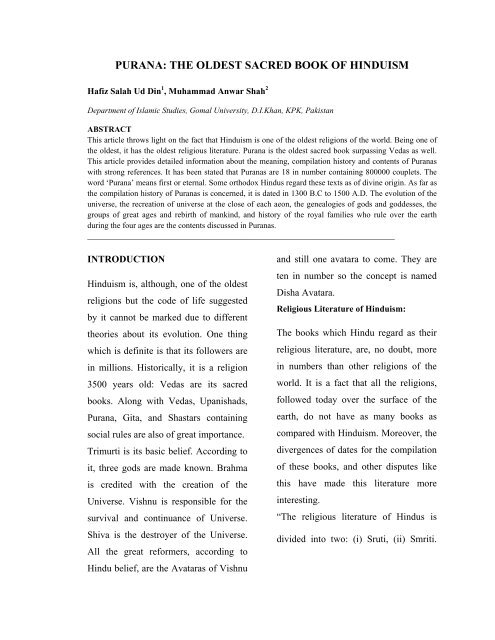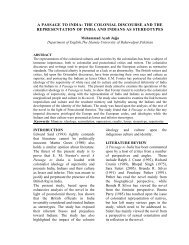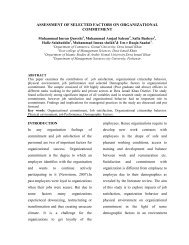The Oldest Sacred Book Of Hinduism - Gomal University
The Oldest Sacred Book Of Hinduism - Gomal University
The Oldest Sacred Book Of Hinduism - Gomal University
Create successful ePaper yourself
Turn your PDF publications into a flip-book with our unique Google optimized e-Paper software.
PURANA: THE OLDEST SACRED BOOK OF HINDUISM<br />
Hafiz Salah Ud Din 1 , Muhammad Anwar Shah 2<br />
Department of Islamic Studies, <strong>Gomal</strong> <strong>University</strong>, D.I.Khan, KPK, Pakistan<br />
ABSTRACT<br />
This article throws light on the fact that <strong>Hinduism</strong> is one of the oldest religions of the world. Being one of<br />
the oldest, it has the oldest religious literature. Purana is the oldest sacred book surpassing Vedas as well.<br />
This article provides detailed information about the meaning, compilation history and contents of Puranas<br />
with strong references. It has been stated that Puranas are 18 in number containing 800000 couplets. <strong>The</strong><br />
word ‘Purana’ means first or eternal. Some orthodox Hindus regard these texts as of divine origin. As far as<br />
the compilation history of Puranas is concerned, it is dated in 1300 B.C to 1500 A.D. <strong>The</strong> evolution of the<br />
universe, the recreation of universe at the close of each aeon, the genealogies of gods and goddesses, the<br />
groups of great ages and rebirth of mankind, and history of the royal families who rule over the earth<br />
during the four ages are the contents discussed in Puranas.<br />
____________________________________________________________________________<br />
INTRODUCTION<br />
<strong>Hinduism</strong> is, although, one of the oldest<br />
religions but the code of life suggested<br />
by it cannot be marked due to different<br />
theories about its evolution. One thing<br />
which is definite is that its followers are<br />
in millions. Historically, it is a religion<br />
3500 years old: Vedas are its sacred<br />
books. Along with Vedas, Upanishads,<br />
Purana, Gita, and Shastars containing<br />
social rules are also of great importance.<br />
Trimurti is its basic belief. According to<br />
it, three gods are made known. Brahma<br />
is credited with the creation of the<br />
Universe. Vishnu is responsible for the<br />
survival and continuance of Universe.<br />
Shiva is the destroyer of the Universe.<br />
All the great reformers, according to<br />
Hindu belief, are the Avataras of Vishnu<br />
and still one avatara to come. <strong>The</strong>y are<br />
ten in number so the concept is named<br />
Disha Avatara.<br />
Religious Literature of <strong>Hinduism</strong>:<br />
<strong>The</strong> books which Hindu regard as their<br />
religious literature, are, no doubt, more<br />
in numbers than other religions of the<br />
world. It is a fact that all the religions,<br />
followed today over the surface of the<br />
earth, do not have as many books as<br />
compared with <strong>Hinduism</strong>. Moreover, the<br />
divergences of dates for the compilation<br />
of these books, and other disputes like<br />
this have made this literature more<br />
interesting.<br />
“<strong>The</strong> religious literature of Hindus is<br />
divided into two: (i) Sruti, (ii) Smriti.
Salah ud Din andr Shah, <strong>Gomal</strong> <strong>University</strong> Journal of Research 27(1): 143-148 (2011) 144<br />
Sruti means revelational. And Smriti<br />
means traditional.”<br />
“<strong>The</strong> most sacred books of <strong>Hinduism</strong><br />
and the oldest literature of India,<br />
represent the religious thought and<br />
activity of the Indo-European speaking<br />
people who entered South Asia in 2 nd<br />
millennium.<br />
Puranas have exerted influence on<br />
<strong>Hinduism</strong> and are in turn reflections of<br />
trends in <strong>Hinduism</strong> – no book can<br />
compare in popularity with the<br />
Bhagavata Purana and the Purana of god<br />
Krishna. <strong>The</strong> most popular part of the<br />
Purana is the description of the life of<br />
Krishna, for which it has since remained<br />
the principal authority.<br />
<strong>The</strong> Puranas are of human origin,<br />
composed by the so-called Rishis.<br />
(Edward, 2007).<br />
Vedas were only recited by Brahmins<br />
while Puranas are exception of this<br />
limited recitation and anyone could<br />
recite these collections. So Puranas are<br />
the most authentic and widely recited<br />
texts in Hindus. (Farooq, 2008)<br />
Meaning of the Word “Purana”:<br />
<strong>The</strong> word ‘Purana’ means first or<br />
eternal. (Edward, 2007)<br />
• Any one of a class of sacred books in<br />
Sanskrit literature, cos mogonical,<br />
legendary,<br />
2008)<br />
religious. (Chamber,<br />
• Origin Sanskrit Purana-Pura, of old .<br />
• (In <strong>Hinduism</strong>) breath as the lifegiving<br />
force. (Oxford Dictionary,<br />
2006)<br />
• Purana: Literally means ‘ancient<br />
story’. (Encyclopedia, 2008)<br />
• To the Hindu mind their name –<br />
archaeologia, ‘the ancient writings –<br />
suggests memorial antiquity.<br />
(Encyclopedia, 2006)<br />
• Purana means ancient religious<br />
books. (Farooq, 2008)<br />
• <strong>The</strong> Puranas means collections of<br />
‘old-world’<br />
(Rapson, 2005)<br />
legends writers.<br />
• Puranas were written down in 1300<br />
B.C. while some were also written in<br />
1500 A.D. (Farooq, 2008)<br />
Edward C. Sachau, in his Alberuni’s<br />
India has some other views about the<br />
compilation of Purana. He says: <strong>The</strong>y<br />
were written from 2 nd century to 9 th<br />
century. <strong>The</strong> last one of these “Bhavesh<br />
Purana” was written in 10 th century in<br />
which Holy Prophet Hazrat Muhammad<br />
(PBUH) and Hazrat Ali (AS) are also
Salah ud Din andr Shah, <strong>Gomal</strong> <strong>University</strong> Journal of Research 27(1): 143-148 (2011) 145<br />
regarded as Avatara of Vishnu. (Edward,<br />
2007)<br />
Klaus K. Klostermaier in his book “A<br />
Concise Encyclopedia of <strong>Hinduism</strong>”<br />
seems to have another idea. His words<br />
are: <strong>The</strong> Puranas themselves claim<br />
greater antiquity than the Vedas. <strong>The</strong><br />
followers of various sects consider them<br />
to be revealed scriptures”. (Klaus, 2001)<br />
Another name, with some other views,<br />
seems on the list is of Bruce M. Sullivan.<br />
He composed a book with the title “A to<br />
Z of <strong>Hinduism</strong>” in which he says:<br />
“Ancient Tales. <strong>The</strong> term is used to refer<br />
to a class of texts that date in their<br />
written form to perhaps the fourth<br />
century C.E. and later, but which also<br />
contain, in many cases, material that<br />
may be a thousand years older than that.<br />
Preserved for centuries as oral traditions,<br />
they were written down, perhaps partly<br />
in response to the written scriptures of<br />
Buddhism and Jainism”. (Bruce,2006)<br />
Importance of Puranas (According to<br />
Hindus):<br />
It is a prominent feature of Puranas that<br />
unlike Vedas and Upanishads (which<br />
were rare, and were in the access of<br />
Brahmins only, and 80% of the<br />
population was unaware of them)<br />
Puranas were in the reach of every one,<br />
and any such restriction was not for<br />
Puranas. This is the reason that these are<br />
most widely recited and most authentic<br />
books for Hindus. (Farooq, 2008)<br />
Some Puranas have attained a status and<br />
authority comparable to the Vedas or<br />
exceeding the Vedas, notably the<br />
Bhagavata Purana in Vaisnava<br />
devotional groups. (Bruce, 2006)<br />
Orthodox <strong>Hinduism</strong> regards these works<br />
as of divine origin, and their frame-work<br />
s stereo-typed in accordance with this<br />
view. <strong>The</strong> chief speaker is some ancient<br />
seer who has received the tradition<br />
through Vyasa, who himself received it<br />
from the creator. (Rapson, 2005)<br />
Puranas (in number):<br />
<strong>The</strong>re are eighteen Puranas, most of<br />
them are called by the names of animals,<br />
humans or angelic beings, because they<br />
contain stories about them or because the<br />
book consists of answers given to certain<br />
questions about the creature whose name<br />
forms the title.<br />
i) Adi Purana i.e. the first.<br />
ii) Mastya Purana i.e. the fish.<br />
iii) Kurma Purana i.e. the tortoise.<br />
iv) Varaha Purana i.e. the bear.<br />
v) Narasimha Purana i.e. a human<br />
being with lion’s head.<br />
vi) Vaman Purana i.e. the dwarf.
Salah ud Din andr Shah, <strong>Gomal</strong> <strong>University</strong> Journal of Research 27(1): 143-148 (2011) 146<br />
vii) Vaya-Purana i.e. the wind.<br />
viii) Nanda-Purana i.e. a servant of<br />
Mahadeva.<br />
ix) Skanda-Purana i.e. a son of<br />
Mahadeva.<br />
x) Aditya – Puirana i.e. the sun.<br />
xi) Soma-Purana i.e. the moon.<br />
xii) Samba-Purana i.e. the son of<br />
Vishnu.<br />
xiii) Brahmand Purana i.e. heaven.<br />
xiv) Markandeya-Purana i.e. a great<br />
Rishi.<br />
xv) Tarkshya-Purana i.e. the bird<br />
Garuda.<br />
xvi) Vishnu-Purana i.e. Narayana.<br />
xvii) Brahma-Purana i.e. the nature<br />
charged with the preservation of<br />
the world.<br />
xviii) Bhavishya-Purana i.e. Future<br />
things. (Edward,2007).<br />
Purana are in fact a bulky collection of<br />
religious literature. Famous puranas are<br />
18 which contain 800000 couplets.<br />
(Farooq, 2008)<br />
While it is possible that there was a<br />
single original Purana, from which 18<br />
major ones somehow derive.<br />
(Encyclopedia)<br />
Contents of Puranas:<br />
Any old-world story may in fact be<br />
called Purana; but the term is especially<br />
applied to certain works which, in<br />
conformity with the classical definition,<br />
deal, or are supposed to deal, with the<br />
following five topics.<br />
i) Sarga, the evolution of the<br />
universe from its material cause.<br />
ii) Pratisarga, the recreation of the<br />
universe from the constituent elements<br />
into which it is merged at the close of<br />
each aeon (Kalpa) or day in the life of<br />
the creator, Brahma.<br />
iii) Vamca, the genealogies of gods<br />
and rishis.<br />
iv) Manvantara, the groups of great<br />
ages (mahayuga) included in an aeon, in<br />
each of which mankind is supposed to be<br />
produced a new from the first father,<br />
Manu.<br />
v) Vamcanucharita, the history of<br />
the royal families who rule over the<br />
earth during the four ‘ages’ (yuga) which<br />
make up one ‘great age’.<br />
Contents & Importance of Puranas<br />
According to Renowned Encyclopedia:<br />
Purana (literally ancient story) is a<br />
general name of a long series<br />
(traditionally 18) of often voluminous<br />
texts that treat in encyclopedic manners<br />
myths and legends, as well as<br />
genealogies, of gods, heroes and saints.<br />
<strong>The</strong>y can loosely be divided into three<br />
groups: those exalting the god Brahma,<br />
those devoted to the god Vishnu, and<br />
those devoted to Siva. <strong>The</strong> division
Salah ud Din andr Shah, <strong>Gomal</strong> <strong>University</strong> Journal of Research 27(1): 143-148 (2011) 147<br />
however is an artificial one. Many deal<br />
with the same or similar materials. <strong>The</strong><br />
puranic literature continues with<br />
upapuranas (sub-puranas) and<br />
Mahatmayas (glorification) of temples<br />
and sacred places.<br />
<strong>The</strong> nature of the works called Puranas<br />
which have been referred to demands<br />
brief explanation. <strong>The</strong> Puranas<br />
commonly recognized in the north of<br />
India are eighteen in number. Others,<br />
about which little is known to European<br />
scholars, are used in the south. A Purana,<br />
according to the Indian definition, best<br />
exemplified by the Vishnu Purana,<br />
should treat of five subjects, namely,<br />
primary creation, secondary creation,<br />
genealogies of gods and patriarchs,<br />
reigns of various Manus, and the history<br />
of ancient dynasties. <strong>The</strong> treatises<br />
consequently are bulky and crowded<br />
with legendary matter of various kinds.<br />
<strong>The</strong>y have been well-described by<br />
Buhler as Popular sectarian compilations<br />
of mythology, philosophy, history, and<br />
the sacred law; intended, as they are now<br />
used, for the instruction of the unlettered<br />
classes including the upper division of<br />
the Sudra varna. Much of the contents<br />
come down from remote antiquity, as the<br />
name Purana, meaning old, testifies, but<br />
the books as they stand are of various<br />
dates. <strong>The</strong> Puranic genealogies of kings<br />
in prehistoric times, seem to be of<br />
doubtful value, but those of the historical<br />
period or Kali age, from about 600 B.C<br />
are records of high importance and<br />
extremely helpful in the laborious task of<br />
reconstructing the early political history<br />
of India. Each of the Puranas is more or<br />
less especially consecrated to the service<br />
of a particular form of the<br />
godhead.(Smith,1983)<br />
<strong>The</strong> Puranas are post-Vedic texts which<br />
typically contain a complete narrative of<br />
the history of the V from creation to<br />
destruction, genealogies of the kings,<br />
heroes and demigods, and descriptions<br />
of Hindu Cosmology and geography.<br />
<strong>The</strong>re are 17 or 18 canonical puranas,<br />
divided in to three categories, each after<br />
a deity: Brahma, Vishnu and Shiva.<br />
<strong>The</strong>re are also many other works termed<br />
Purana, known as “Upapuranas.”<br />
Puranas are considered reliable texts<br />
after Upanishads. It is generally read and<br />
recited. <strong>The</strong> history of early Aryan tribes<br />
and the life of Hindu gods are the<br />
contents of Puranas.<br />
<strong>The</strong> most important is Bhavishya<br />
Purana. It is named so as it serves as a<br />
parameter of events to happen in the
Salah ud Din andr Shah, <strong>Gomal</strong> <strong>University</strong> Journal of Research 27(1): 143-148 (2011) 148<br />
future. Hindus regard it the word of God.<br />
Vyas has just compiled it but its real<br />
author is God Himself.( Zakir, 2002)<br />
To the Hindu mind, their mane<br />
‘Archaeologia’ the ancient writings<br />
suggests immemorial antiquity. It has<br />
been the habit of critics to date the best<br />
known of them, Visnu Purana, about<br />
A.D 1045. It has, however, recently been<br />
proved that this and other important<br />
works of the same series must be dated<br />
about A.D 500 while the Vayu Purana is<br />
referred to the 4 th century, and all the<br />
principal works, which in their present<br />
form are recensions of a much older<br />
body of literature, were re-edited in the<br />
Gupta period (320-480A.D) when the<br />
study of Sanskrit was revived.<br />
(Encyclopedia)<br />
CONCLUSION<br />
In the light of given information it may<br />
be humbly concluded that Puranas are<br />
the most sacred oldest religious scripture<br />
of <strong>Hinduism</strong>, one of the oldest religions<br />
of the world. <strong>The</strong>y hold a very important<br />
position. <strong>The</strong>y are important for their<br />
availability and easy access to every one,<br />
not only for a particular caste like Vedas<br />
and Upanishads. <strong>The</strong>y are a great source<br />
of knowledge regarding their contents.<br />
One finds a detailed account of creation<br />
of the universe, the stories of gods and<br />
goddesses, their battles, their love affairs<br />
and their encounters with evil spirits in<br />
them.<br />
REFERENCES<br />
Bruce M S (2006). A to Z of <strong>Hinduism</strong>, Vision<br />
<strong>Book</strong>s, Dehli, P- 165.<br />
Chambers (2008). 20 th Century Dictionary,<br />
England, Page-1046.<br />
Encyclopedia of Religion and Ethics (2006).<br />
Vol: VI, P- 695.<br />
Edward C S (2007). Dr. Al-Beruni’s India, Sange-Meel<br />
Pulication, Lahore P-144.<br />
Farooq K (2008). Islam for Indian Religions.<br />
Defenders of Islam Trust Lahore, P-53.<br />
Klaus K K(2001). A Concise Encyclopedia of<br />
<strong>Hinduism</strong>, One World Publication, England, P-<br />
143.<br />
New Encyclopedia Britannica (2008). Vol: 8, P-<br />
938.<br />
Oxford (2006). Australian Dictionary, Oxford<br />
<strong>University</strong> Press, P- 673.<br />
Rapson (2005). <strong>The</strong> Cambridge History of India,<br />
V-1, S. Chand & Company Delhi, P- 264.<br />
Rapson (2006). <strong>The</strong> Cambridge History of India,<br />
Vol: I, P- 265.<br />
Smith (1983). <strong>The</strong> Oxford History of India.<br />
Oxford <strong>University</strong> Press, Karachi, P-60-61<br />
<strong>The</strong> New Encyclopedia Britainnica (2008). Vol:<br />
8, P- 9<br />
Zakir N (2002). Islam & <strong>Hinduism</strong>,<br />
Translated by M. Zahid Malik, Zubair<br />
Publication, Lahore, Page 22.











